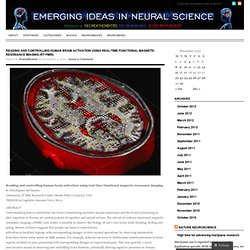

Marijuana without the high: A painkiller breakthrough. Study illuminates the 'pain' of social rejection. Physical pain and intense feelings of social rejection "hurt" in the same way, a new study shows.

The study demonstrates that the same regions of the brain that become active in response to painful sensory experiences are activated during intense experiences of social rejection. "These results give new meaning to the idea that social rejection 'hurts'," said University of Michigan social psychologist Ethan Kross, lead author of the article published in the Proceedings of the National Academy of Sciences. "On the surface, spilling a hot cup of coffee on yourself and thinking about how rejected you feel when you look at the picture of a person that you recently experienced an unwanted break-up with may seem to elicit very different types of pain.
"But this research shows that they may be even more similar than initially thought. " These regions are the secondary somatosensory cortex and the dorsal posterior insula. Neuroscience and Pain Science for Manual Physical Therapists (3) Functional magnetic resonance imaging. Researcher checking fMRI images Functional magnetic resonance imaging or functional MRI (fMRI) is a functional neuroimaging procedure using MRI technology that measures brain activity by detecting associated changes in blood flow.[1] This technique relies on the fact that cerebral blood flow and neuronal activation are coupled.

When an area of the brain is in use, blood flow to that region also increases. The primary form of fMRI uses the Blood-oxygen-level dependent (BOLD) contrast,[2] discovered by Seiji Ogawa. The procedure is similar to MRI but uses the change in magnetization between oxygen-rich and oxygen-poor blood as its basic measure. This measure is frequently corrupted by noise from various sources and hence statistical procedures are used to extract the underlying signal. FMRI is used both in the research world, and to a lesser extent, in the clinical world. Overview[edit] History[edit] Three studies in 1992 were the first to explore using the BOLD contrast in humans. The Placebo Effect. Emerging Ideas in Neural Science. Reading and controlling human brain activation using real-time functional magnetic resonance imaging (rt-fMRI) « Emerging Ideas in Neural Science. Reading and controlling human brain activation using real-time functional magnetic resonance imaging (rt-fMRI) Posted by brainchemist on November 4, 2010 · Leave a Comment Reading and controlling human brain activation using real-time functional magnetic resonance imagingR.

Christopher deCharms Omneuron 3T MRI Research Center, Menlo Park, CA 94025, USA TRENDS in Cognitive Sciences Vol.11 No.11 ABSTRACT Understanding how to control how the brain’s functioning mediates mental experience and the brain’s processing to alter cognition or disease are central projects of cognitive and neural science. The advent of realtime functional magnetic resonance imaging (rtfMRI) now makes it possible to observe the biology of one’s own brain while thinking, feeling and acting. Personal notes: How does the brain mediate mental experience? Both are projects central to cognitive and neural sciences. rtFMRI: allows you to observe the biology of your brain while thinking, feeling and acting. A. C. D. C. Pain Medication Options - Types of Pain Medications. What are the different types of pain medication options?

: Patients suffering from painful conditions need options to help treat their symptoms. The best pain control can be achieved by trying to target appropriate medications for the underlying problem, and trying to minimize pain with different medication and non-pharmaceutical treatments. Learn about different types of medications used to control pain. Acetaminophen: Tylenol (Acetaminophen) is used to treat pain. Non-Steroidal Anti-Inflammatory Medications (NSAIDs): The NSAIDs (such as Ibuprofen, Motrin, Aleve, etc.) are most beneficial in cases of acute pain, or flare-ups in patients with chronic pain. Corticosteroids: As with NSAIDs, corticosteroids are powerful anti-inflammatory medications, and best used for acute pain or for flare-ups of a chronic inflammatory problem.
Narcotics: Narcotics should be considered if pain cannot be otherwise controlled. Anti-Convulsants: Versatis 5% Medicated Plaster - X-PIL. Pain Management - Fora.tv.